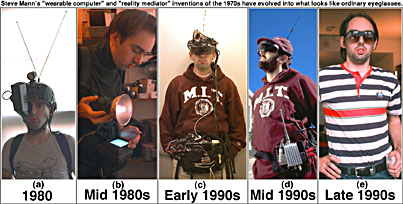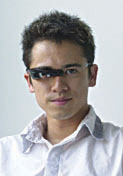
Steve Mann's wearable computer and reality mediator inventions of the 1970s have evolved into what looks like ordinary eyeglasses.
The bionic Mann
"Human nature is to modify ourselves," said University of Toronto professor of electrical engineering Steve Mann in his January 26 lecture, "At the Nexus of Body and Technology." He was sponsored by the McGill Science Undergraduate Society as part of their Academia Week. Mann discussed ways of seeing, modifying and communicating our visual reality using his next-generation digital eyeglasses.
These digital eyeglasses, called "EyeTap devices," analyze incoming light and synthesize outgoing light. Light that would normally be altered by refraction in analog lenses is absorbed by sensors in the frames and turned into binary data. This data is then modified by a processor, according to the individual's prescription, and sent from the frames back to the eye. His current version does this almost instantaneously. Mann predicts that refractive eyeglasses will soon become obsolete and people will download their prescriptions from the internet.
Because these EyeTap devices function computationally, they have many advantages over traditional glasses. With a face-recognition option, they can put virtual name-tags on faces for people who have trouble remembering names. They can be used as infrared glasses or to block advertisements. Mann calls them reality mediators because of the possibilities they open up in terms of augmenting, diminishing and otherwise modifying a user's visual experience of the world.
The next step would be to use this technology for communication, with output streaming from the device to the internet or to a remote user who would be able to see whatever the person looked at. The remote user could interact using pointers or by drawing on the image, which would be sent back to the EyeTap user, appearing on her field of vision. For example, an auto mechanic could remotely help someone fix their car; the person would only have to look at the engine and the mechanic would see it and give instructions. Mann foresees widespread use of this function for architects and builders, surgeons, security officers and in many other professions.
During the course of the lecture, the output from Mann's own glasses streamed to the projector screen behind him, so whatever he saw, the audience saw. When he wanted to demostrate a concept using a diagram, all he had to do was hold a notepad up to his face and draw on it with a marker, and it would be visible to the crowd.

The latest in EyeTap technology
Mann has created a CyborgLog, or "glog," an online journal of his day-to-day visual experiences (akin to a text-based WebLog, or "blog"), though often people he meets are uncomfortable with the possibility of being recorded and broadcast onto the web. The resistance to his glog activity is most severe in casinos and other establishments that regularly videotape their patrons. "The more surveillance cameras there were in a place, the more objections there were to my own camera," he recalled.
Mann considers the creation of his glog an act of sousveillance, "looking from below," as opposed to surveillance, "looking from above." The concept of sousveillance raises questions about who has the right to survey whom.
Technological questions often lead to sociological ones; as a response to being "looked at," "people looking back" may signal a new form of subversion.
Mann said he has developed this technology since 1980 with an interpassionary, as opposed to interdisciplinary, approach to invention. Interpassionary creation implies a holistic system of discovery, an intellectual playground, a fusion of passion and profession. This blurring of boundaries has led Mann to create art like Deconcert, an interactive exhibition/performance in which EEG signals from the brains of participants were used to control a jazz orchestra and the lighting, forming a "stream of deconsciousness."
Although Mann foresees an ever-expanding range of creative and practical uses for technology, he sees his inventions as a way to empower individuals in the face of technological encroachment. "I'm a cyborg Luddite. I oppose technology with technology."
For more information on Mann and his works, go to www.eyetap.org, wearcam.org, or www.eecg.tor-onto.edu/~mann.
